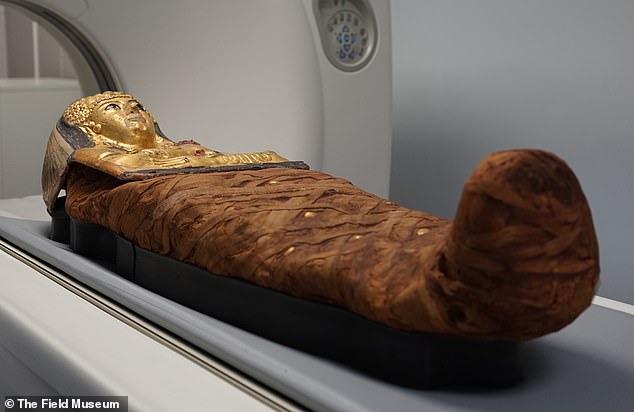X-ray scans have finally answered the mystery of how a famous Egyptian mummy was placed inside a coffin without an opening.
Scientists were able to see Lady Chenet-aa’s sarcophagus for the first time and finally understand how she was embalmed 3,000 years ago.
For years, researchers searched for an opening in the cavity and found only a small space near his feet that would not have been large enough to fit his body.
The lack of visible openings or entry points in Chenet-aa’s coffin had prevented researchers from accessing her remains, but new CT scans have eliminated some of the questions that have plagued scientists for decades.
When the team ran the coffin through the CT scanner, they were able to get a deeper look at the bottom, where “you can start to see there’s a seam going down the back and some cords,” said JP Brown, senior curator of Anthropology.
Researchers at the Field Museum in Chicago estimated that she was between 30 and 40 years old when she died, and detailed efforts to prepare her for the afterlife confirmed that she had a high social position.
The new scans revealed that Chenet-aa lived in Egypt’s Third Intermediate Period, during the 22nd Dynasty, and is still in “remarkable condition.”
The team was also able to discern information about her age, diet, and how the embalmers prepared her for the afterlife.
New CT scans of Lady Chenet-aa have allowed researchers to learn her age, her diet and how she was embalmed.
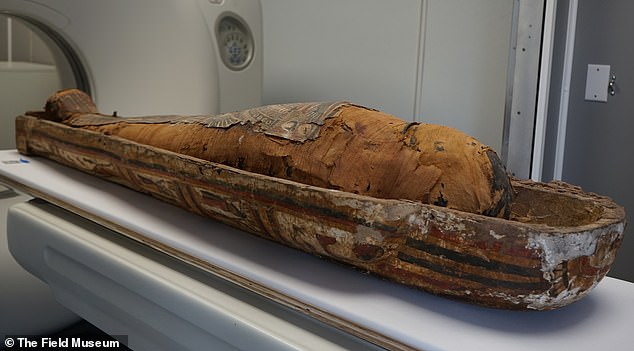
The scans created 3D images of Chenet-aa’s body alongside a second mummy named Harwa, who was also considered a high-status individual at the time.
Researchers studied two of the 26 mummies on display at the Field Museum in September to find out how they were prepared for the afterlife.
Using 3D scanning technology, they created x-rays of the skeletons and artifacts that were contained within the coffins for thousands of years.
The most unusual aspect of Lady Chenet-aa’s coffin was the fact that it appeared to have no seams or openings that would have allowed the embalmers to place her body inside.
However, 3D scans revealed that instead of building the cartonnage around the body, as was common for the ancient Egyptians, the coffin was created first and then softened with moisture so that it was flexible and could be molded around Chenet-aa.
Embalmers placed padding in his windpipe so that it would not collapse when he was standing, while a slit was cut from the top to the bottom of the coffin and placed over his wrapped body.
After tying the back of the coffin, they placed a wooden panel at its feet and secured it in place to prevent it from moving while they molded the coffin.
“From an archaeological perspective, it’s incredibly rare that you can research or see history from the perspective of a single individual,” Drake said.
“This is a really great way to see who these people were, not just the things they did and the stories we’ve made up about them, but the actual individuals who were living at that time.”
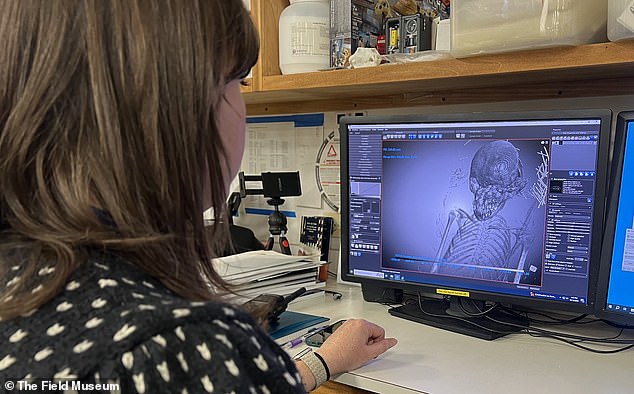
The 3D renderings showed that artificial eyes were placed in Chenet-aa’s eye sockets and that the sons of Horus were placed in her body cavity next to her organs.
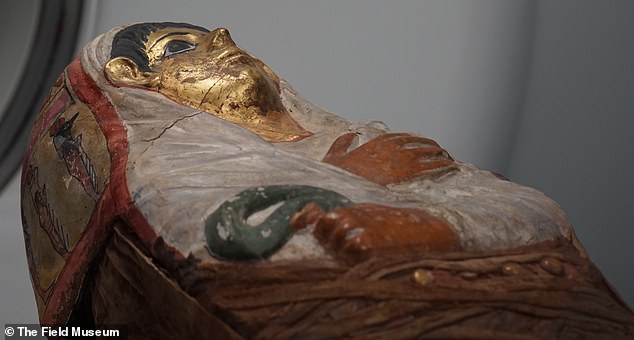
The CT scans took three days to complete, but researchers said it could take up to three years before they can fully review the images.
They also noted that Chenet-aa was wrapped in layers of expensive linen and placed in a coffin of decorated cartonnage, a type of brightly painted molding similar to papier-mâché that was reserved for elite burials.
Unlike other mummies whose internal organs were placed in separate jars with the four sons of Horus on the lids, embalmers took a different approach for Chenet-aa.
Scans showed that in his case, embalmers created packages in which the organs were placed along with six wax statues of the sons of Horus that were reinserted into the body cavity.
The four sons of Horus included Imsety, who was the human-headed god who protected the liver, and Hapy, who was baboon-headed and protected the lungs.
The second two were identified as Duamutef, who had the head of a jackal and was designated to protect the stomach, while Qebehsenuef, with the head of a falcon, protected the intestines.
The images showed that he had lost several teeth and the remaining ones had signs of significant wear, indicating that his food contained grains of sand that wore down the enamel.
He also revealed that embalmers replaced his eyes with artificial ones to ensure they did not deteriorate over time.
‘The Ancient Egyptian view of the afterlife is similar to our ideas about retirement savings. “It’s something you prepare for, save money for your entire life and hope you have enough at the end to really enjoy it,” Brown said.
‘The additions are very literal. If you want eyes, then there needs to be physical eyes, or at least some physical allusion to eyes.
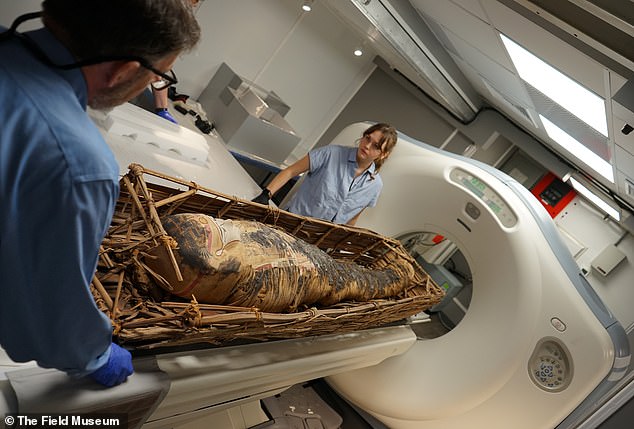
Scans revealed that the embalmers had placed Chenet-aa inside the coffin instead of molding it around her body.
The researchers also focused on a second mummified individual known as Harwa who lived around the same time as Chenet-aa and was also believed to be of high social status.
3D images of his spine showed that he did not suffer from any ailments related to physical work, and his well-groomed teeth reflected that he had access to quality food that was only available to the elite.
The main goal of their research was to demonstrate that the mummies were people and not just art objects, according to the museum.
“We’re trying to understand them as people so we can share those stories and knowledge with the general public to rehumanize and change the narratives to be more respectful and give more dignity to these mummified individuals,” Drake said. cnn.
The scans took about four days; However, the researchers said a full analysis of their findings could take up to three years to complete.

